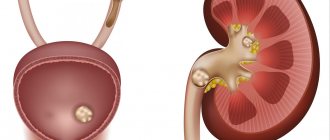Pyelonephritis is an acute or chronic inflammation of the renal parenchyma and pelvis, which is often accompanied by fever and pain. The most common cause of the acute form is an ascending infection. Vesicoureteral reflux also often causes this pathology. In addition, hematogenous downward infection may occur. Urinalysis for pyelonephritis helps to identify associated complications. In the International Classification of Diseases, 10th revision (ICD-10), kidney inflammation of various etiologies is designated by codes N10-N16.
How to take a urine test for pyelonephritis
A general urine test is currently the most common research method. It is prescribed to all patients for preventive and diagnostic purposes. If pyelonephritis is suspected, such a study will help confirm the diagnosis.
In order for the study to be accurate, urine must be collected correctly. If you make a mistake during the test process, you can provoke false results, then you will have to retake the test, or the doctor will prescribe unnecessary treatment.
The procedure for submitting urine for analysis for pyelonephritis:
- Before taking the test, you should not take diuretics. If the patient starts taking diuretic herbs or tablets, this should be reported to the doctor who prescribes the test.
- The same thing happens with antibiotics. If the patient suddenly began to take such a drug at his own request, he needs to be honest.
- The day before collecting urine, you should not eat foods or use drugs that color urine, in particular, beets, carrots, and acetylsalicylic acid.
- Collect urine in a sterile container. Doctors recommend purchasing it at a pharmacy rather than trying to sterilize a glass jar at home.
- Before taking the test, you need to wash yourself well, then wipe your genitals dry.
- Women are advised to cover the vaginal opening with a cotton swab, especially during menstruation, to prevent discharge from getting into the urine. There is no need to insert the tampon too deeply, just cover the entrance to the vagina with it, and then urinate.
- They donate the first morning portion of urine, since the concentration of substances in it is maximum, which will help to obtain an accurate analysis.
- Before urinating, women need to spread their labia, and men need to retract their foreskin so that urine does not come into contact with the skin.
- For a general analysis of pyelonephritis, the entire portion of urine is collected, and not the average, as in the Nechiporenko analysis.
- Biological material must be delivered to the laboratory as quickly as possible, but no later than 1.5 hours after collection.
Many patients are interested in what difference it makes whether to collect the entire portion of urine or a few milliliters. Experts are still arguing about this; some believe that it is enough to collect an average portion of urine, while others require an analysis of the entire volume of urine.
The fact is that urine travels a long way through the kidneys, bladder and urethra. The very first drops of urine wash away the bacteria that are in the urethra; in the middle portion of urine you can find pathogens in the upper urinary tract, in particular in the kidneys and ureter. And the very last portion of urine will show the condition of the bladder.
How is it diagnosed?
When making a diagnosis, methods for obtaining results play a primary role. Without research, it is difficult to find out the type of disease and its accompanying ailments. With their help, the composition, smell of urine, color, density, transparency, amount of sugar and protein in it are determined. If microorganisms are present, their sensitivity to antibiotics will be determined. The therapist prescribes a general urine and blood test for the patient, a blood test for sugar, and an ultrasound scan of the kidneys.
Indicators of general urine analysis for pyelonephritis
To study a general urine test for pyelonephritis, the laboratory technician evaluates the following indicators.
Color and transparency . A specialist evaluates the appearance of urine by eye. Urine should be clear, ranging from pale yellow to rich in color. The color of urine during pyelonephritis may not change, it all depends on the stage of the disease. If the patient has pyelonephritis and urolithiasis, the urine will be cloudy, impurities of pus may appear, resulting in an uncharacteristic and unpleasant odor. Blood in the urine during pyelonephritis occurs in advanced forms of the disease; it will color the liquid pink.
Foaminess . If you shake the urine of a healthy person, it should practically not foam; only a few bubbles appear on the surface. Foaming in pyelonephritis can be quite pronounced, this is due to the appearance of protein in the biological fluid.
Urine density . A urine test for pyelonephritis in a child should show a density from 1.012 to 1.020. In adults, this figure ranges from 1.010 to 1.022. Increased density in pyelonephritis occurs due to the appearance of various impurities in urine: bacteria, proteins, red blood cells, etc.
Acidity . The pH of urine of a healthy person varies from 4 to 7 units. An elevated PH level may indicate an inflammatory process in the genitourinary system. A pH level of 9 can tell the doctor that the sample was most likely stored incorrectly or was brought to the laboratory too late. Then you will have to retake the analysis according to all the rules.
Urologist: if you want to get rid of cystitis so that it doesn’t come back, you just need to dissolve Read more »
Protein in the urine with pyelonephritis is increased. If the normal value is 0.033 g/l and no more, then pyelonephritis is characterized by a protein level of 1 g/l. It is important to note that in children, protein in the urine can be increased not only with pyelonephritis, sometimes this is a developmental feature.
Bilirubin . Normally, this substance should not be in the urine. Increased bilirubin is observed in urolithiasis, liver pathology and other diseases.
acetone in the urine, both in a healthy person and in patients with pyelonephritis. An increase in this indicator may indicate diabetes mellitus, the results of starvation and alcoholism.
Red blood cells and white blood cells should be absent in the urine or present in a small amount, 0-3 in the field of view. An increase in red blood cells is observed in urolithiasis, and increased white blood cells confirm pyelonephritis and other inflammatory kidney diseases.
Bacteria and fungi should not normally be present in urine. If they are found, it means that an infectious inflammation is occurring inside the genitourinary system; it is quite possible that this is pyelonephritis. If the patient collected urine incorrectly, for example, did not wash himself well, or the jar was unsterile, the analysis may be false.
Unfortunately, using a general urine test it is impossible to immediately identify the causative agent of pyelonephritis. For this purpose, additional studies are carried out: bacteriological culture and PCR analysis. Thanks to the first, it is possible to determine sensitivity to antibiotics, and with the help of PCR, even hidden infections can be detected in very small quantities.
Diagnosis of pyelonephritis: basic methods
Pyelonephritis is an infection of the renal pelvis involving the parenchyma, especially the interstitial tissue and tubules. The clinic is characterized by high fever, chills, flank pain, gastrointestinal disorders and symptoms of cystitis.
Diagnosis of pyelonephritis begins with laboratory tests of urine (leukocytes, proteinuria, red blood cells). In practice, the diagnostic marker is a bacterial value = 104 CFU/ml. To exclude obstacles, it is necessary to perform an ultrasound. If the febrile phase of antibiotic therapy lasts longer than 72 hours, additional examinations should be used to differentiate urolithiasis, abscesses or other complications - CT, urogram (radiation picture) or DMSA scan.
Pregnant women (especially those with gestational diabetes) and children with urolithiasis and other complicating factors should first be treated in hospital with a parenteral antibiotic. Pre-hospital prophylaxis is also carried out. Patients with recurrent pyelonephritis should undergo further evaluation. Early and effective antibiotic therapy can prevent damage to parenchymal tissue.
It is important to know! Routine microbiological examination after successful therapy is not required. Typically, the use of urine test strips is sufficient. More extensive testing, including urine culture, should be performed in patients who remain symptomatic after three days or have had a recurrent infection within two weeks.
In patients with urological complications, it is necessary to determine the type of resistant pathogen; therapy must be carried out with another substance. If it is a reinfection, 6 weeks of treatment with the original antibiotic is usually successful.
Urinalysis according to Nechiporenko
Since urine passes through the kidneys, urethra and bladder, it is difficult to understand from the average portion where exactly the bacterial infection is located. To check whether there is inflammation in the kidneys, doctors order a Nechiporenko test, that is, collect an average portion of urine.
WHAT DO THE DOCTOR'S SAY?
Doctor of Medical Sciences, Honored Doctor of the Russian Federation and Honorary Member of the Russian Academy of Sciences, Anton Vasiliev:
“I have been treating diseases of the genitourinary system for many years. According to statistics from the Ministry of Health, cystitis in 60% of cases becomes chronic.
The main mistake is delaying!
The sooner you start treating cystitis, the better. There is a remedy that is recommended for self-treatment and prevention of cystitis at home, since many patients do not seek help due to lack of time or shame. This is Ureferon. It is the most versatile. It contains no synthetic components, its effect is mild, but noticeable after the first day of use. It relieves inflammation, strengthens the walls of the bladder, its mucous membrane, and restores general immunity. It is suitable for both women and men. For men there will also be a pleasant bonus - increased potency. » READ FULL INTERVIEW»
The Nechiporenko analysis for pyelonephritis requires the same preparation as the general analysis. But it needs to be taken differently. For proper collection, you must first release a certain amount of urine into the toilet, then place a jar and collect about 50 ml of liquid, and release the rest into the toilet. This will be the average portion of urine. Biological material must be collected strictly in the morning on an empty stomach.
Normal urine values for pyelonephritis can be seen in the table:
| Element | Normal quantity |
| Red blood cells | 1000 per ml |
| Leukocytes | 2000 per ml |
| Cylinders | Up to 20 |
With pyelonephritis, an increase in leukocytes is observed and bacteria are detected. Also, during the inflammatory process, protein appears, and the environment becomes acidic, this leads to the formation of cylinders. Typically, the laboratory technician detects epithelial and hyaline casts.
Symptoms
There are two forms of the disease: chronic and acute. The differences between them are based on the nature of the inflammation. With the development of the acute form, changes occur in the kidneys, resulting in the development of a cellular infiltrate. In the chronic form of the disease in humans, functionally active epithelial cells, which are structural and functional elements of the internal parenchymal organ, are damaged.
Symptoms of acute pyelonephritis
- Chills, high temperature;
- Frequent urge to urinate;
- Profuse sweating;
- Vomiting/nausea;
- Lumbar, joint pain;
- Weakness and migraines;
- Dryness and pallor of the skin.
Taking a blood test for pyelonephritis, pus is detected. The content of red blood cells, protein and bacteria in this case is high. It is difficult to identify the disease in children, as the clinical data and picture are blurred.
If acute illness is not treated in time, a chronic illness will develop. Sometimes it is caused by infectious, viral diseases and hypothermia. According to statistics, the disease is more often diagnosed in women due to the structural features of the organs. Symptoms appear constantly or there is a lull, followed by a protracted phase of exacerbation. Therefore, phases are distinguished: active inflammation, latent form and remission.
Blood from a finger
A blood test is taken in the morning before meals, after an eight-hour fast. Before taking the test, it is not advisable to drink alcohol for several days, and the day before, drink a lot of fluids and physically overexert yourself. But it’s okay if you had to donate blood for analysis unexpectedly. Indicators regarding pyelonephritis change little from violation of these recommendations.
The general analysis is a list of blood elements in units appropriate for each group:
- With any kidney disease, nephrogenic anemia gradually develops. In a blood test, this will be manifested by a decrease in the number of red blood cells and a simultaneous decrease in hemoglobin. And the color indicator, regardless of the level of anemia, will always be normal.
- As for white blood, the number of leukocytes in the analysis will increase (leukocytosis) depending on the intensity of the inflammatory process. In case of acute inflammation or exacerbation of chronic inflammation, leukocytosis will be significant. Purulent inflammation in the kidneys will manifest itself as a leukemoid reaction: leukocytosis in the analysis will increase so much that doctors will have to exclude leukemia.
- Chronic pyelonephritis will cause slight leukocytosis, and in the leukocyte formula the number of band elements will increase more than segmented ones. This situation is called a shift in the leukocyte formula to the left.
- The chronic course of pyelonephritis will also be indicated by a decrease in the erythrocyte sedimentation rate: in the analysis form, the ESR numbers will be high.
What you need to know about pyelonephritis
Inflammation is actually a universal pathological process in the human body. Often its target is the tissue of the cups and pelvis of the kidney, which is the beginning of the urinary tract. In most cases, this situation is caused by the proliferation of pathogenic microorganisms.
With pyelonephritis, the tissue of the renal pelvis and cups of the kidney becomes inflamed
Throughout the course of the disease, a struggle occurs in the kidneys between bacteria and the body’s immune system. At the same time, microorganisms and special blood cells - leukocytes - die in large numbers, after which they are excreted along with the urine.
In addition, against the background of inflammation, bacteria and leukocytes stick together, clogging the lumen of special tubes - the kidney tubules. As a result, the resulting sticky mass called a “cylinder” is excreted in the urine. With pyelonephritis, the amount of crystalline substances increases - salts of uric, oxalic and phosphoric acid. They become the main component of urine sediment.
Kidney inflammation - video
Types of research
When a doctor suspects a patient has pyelonephritis, blood and urine tests should be taken on the same day. But one-time studies are usually not enough, and it is necessary to consider all the results only in dynamics.
Typically, several types of analysis are used:
- General. Helps determine the presence of an active inflammatory process.
- According to Nechiporenko. It is carried out in the absence of pronounced changes in urine, and allows you to determine the predominance of leukocytes over other elements.
- According to Zimnitsky. The collection is carried out for differential diagnosis of kidney pathology. Allows you to see the volume of daily diuresis, the presence of renal failure, and find out the specific density of urine. Often performed when urinary tract infections are suspected in children.
- For sterility. Helps in treating the disease. With its help, the type of pathogenic flora and its sensitivity to antibacterial agents are determined.
- For the presence of urogenital infection. This allows you to confirm or exclude the presence of specific flora.
Which type of urine test for pyelonephritis is most important? To answer this, we should consider in more detail what each of the methods consists of, and the degree of its informativeness for this disease.
Tired of fighting kidney disease?
SWELLING of the face and legs, PAIN in the lower back, CONSTANT weakness and fatigue, painful urination? If you have these symptoms, there is a 95% chance of kidney disease.
If you care about your health , then read the opinion of a urologist with 24 years of experience. In his article he talks about RENON DUO capsules.
This is a fast-acting German remedy for kidney restoration, which has been used all over the world for many years. The uniqueness of the drug lies in:
- Eliminates the cause of pain and brings the kidneys to their original state.
- German capsules eliminate pain already during the first course of use and help to completely cure the disease.
- There are no side effects and no allergic reactions.
Urinalysis indicators for pyelonephritis play an important role, since this disease often occurs without severe symptoms. And determining the severity of the process, as well as finding out how severe the pathology is, is possible only by obtaining urine results.
Assessment of kidney excretory capacity
It is necessary, first of all, to assess the performance of the glomeruli of the kidneys and pelvis.
It is necessary, first of all, to assess the performance of the glomeruli of the kidneys and pelvis. This is not difficult to do through a simple calculation: the amount of urine excreted per day should be 500 ml less than the amount of liquid drunk during the same day.
Causes of prolapsed kidney: symptoms and treatment
Note! With kidney inflammation, as a rule, the volume of urine produced is increased.
Frequent emptying of the bladder at night may also indicate pyelonephritis or cystitis. With increased protein or sugar, the urine may foam. A foul odor indicates the presence of infection. An unpleasant odor may accompany ketonuria with increased acidity of urine or the presence of acetone.
In what case is it necessary to take a blood test for biochemistry?
This type of examination is prescribed by a specialist if there is a suspicion of improper kidney function. The analysis for pyelonephritis will show that the amount of nitrogenous products and urea has increased.
As a rule, blood for biochemistry is collected from the vein of the left wrist. Also, with this type of examination, as with the general examination, you must not eat for 9 hours and come to the analysis room in the morning. You should follow the rules for preparing for the assigned study. This is what will ensure the reliability of the tests and diagnosis made by the doctor.










